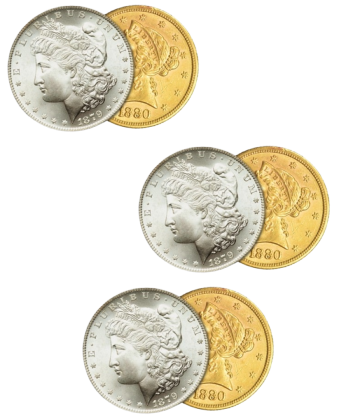ALLOY – A solid mixture of two or more chemical elements, including at least
one metal. In
the case of gold, it is mixed with a baser metal or metals to lower the purity, influence the
color or add
durability.
ANODE – Generally refers to impure copper cast into a special shape for
incorporating into
an electrolytic refinery for the final purification process.
ASSAY – The testing of gold or silver to determine its fineness or purity.
ASSAY MARK – The stamp by an assayer on a bar or piece of precious metal to
guarantee its
fineness.
BENEFICIATION – Quite a buzzword these days, in the gold sector, beneficiation
of product means adding value to gold beyond the price
at which gold is traded internationally.
BLANK – A blank disc of metal with milled edges used to make a coin.
BULLION– The generic word for gold and silver in bar or ingot form.
BULLION ASSAY – Analysis of Gold and Silver in bullion using
Proof-Corrected Fire Assay. Sample types include mine bullion, fine gold
and jewellery as well as dental alloys.
BULLION COINS– Contemporary precious metal coins minted by official
agencies in unlimited numbers for investment purposes.
CARAT -
- A measure of the weight of precious stones. 1 carat = 0.2053 gm
- A measure of the proportion of gold in a gold alloy, on the basis that 24 carat is pure
gold, often expressed as K or k,
eg 18k is 75% gold.
CAST BAR – A cast bar is made by the process of forming a bar in a mould
(contrast minted bar)
CERTIFIED GOLD – Certification adds one dimension to the requirements of
responsible gold by guaranteeing that the gold was also mined
with respect to the environment and not recycled from scrap or other secondary, untraceable
sources as well as that the
chain of custody through refining was traceable.
COMEX – The Commodity Exchange in New York, a division of NYMEX.
CUSTOM SMELTING – Basically this means that materials received from customers
(mostly borax slags and dust) are loaded through an arc
furnace, mixed with fluxes and reductant to form three major products: slag, metal and flue
dust.
DELIVERY– The actual transfer of the ownership of gold or silver. It may not
involve physical movement of metal and is usually
made by a simple paper transfer in the LBMA clearing system.
DMCC– A strategic initiative of the Dubai government, The Dubai Multi
Commodities Centre (DMCC) was created to establish a
commodity market place in Dubai, and provide industry-specific market infrastructure and a full
range of facilities for
the gold and precious metals, diamonds and coloured stones, energy and other commodities
industries.
DME–The Department of Minerals and Energy, which is the regulatory body for
minerals and energy resources in Mauritius.
DORE– An unrefined (therefore impure) alloy of gold with variable quantities of
silver and smaller quantities of base
metals, which is produced at a mine before passing on to a refinery for upgrading to London Good
Delivery standard,
usually consists of 85% gold on average.
DME–The Department of Minerals and Energy, which is the regulatory body for
minerals and energy
resources in Mauritius.
DQS– DQS, based in Germany, is the first assessment and certification
organization to be authorized for almost all
standards and specifications. The service spectrum comprises assessments according to more than
70 recognized standards
and technical or industrial specifications, as well as internal company requirements. Website:www.dqscert.com
EAGLE – The earliest legal tender US gold coin first minted in 1795. It is 900
fine
EVALUATION – The evaluation of gold through assaying to assess a measure of
purity or fineness of the gold.
FACE VALUE – The value of a coin or paper money, as printed on the coin or bill
itself by the minting authority. While the face
value usually refers to the true value of the coin or bill in question, it can sometimes be
largely symbolic, as is
often the case with bullion coins.
FERRULE – A metal ring or cap put around the end of a pole or shaft to prevent
splitting or to give added strength.
FINDINGs – Findings are the components that jewellery makers use to assemble
their jewellery and include items such as clasps,
earring backs and hooks.
FINENESS – The proportion of precious metal in an alloy expressed as parts per
1000.
GOLD– Latin name Aurum. Chemical symbol Au.
GOLD FIXING – Held twice each working day at 10.30am and 3.00pm GMT.
GOLD LOAN – The provision of finance in gold for a gold-related project or
business, typically in mining or jewellery inventory
finance, which provides a combination of generally inexpensive funding together with built-in
hedging.
GOLD STANDARD– A monetary system with a fixed price for gold, and with gold
coin
either forming the whole circulation of currency
with in a country or with notes representing and redeemable in gold.
GOLD DELIVERY – The specification which a bar must meet in order to be
acceptable for delivery in a particular market, for example
London Good Delivery.
GRAIN– One of the earliest units of weight for gold, one grain being the
equivalent of one grain of wheat taken from the
middle of the ear.
GRANULES– Bullion, including its various alloys presented for sale in
granulated form, often referred to as grain.
HALLMARK– A mark or number of marks made on gold or silver jewellery and other
fabricated products to confirm that the quality
is of the fineness marked on the item.
INTERNATIONAL STANDARDISATION ORGANISATION – The ISO is a network of national
standards institutes in 153 countries on the basis of one member per country. The
Central Secretariat is based in Geneva and the Mauritius member of the ISO is the Mauritus
Bureau of Standards
(SABS).
JUST-IN-TIME STOCKS– These are gold or silver bars which are warehoused by Aurum 79 close to the client’s premises, to ensure a fast
supply when required. The stock is paid for by the client when the metal is taken out of the
stock.
KILOBAR– (1000 grams) is the world’s most widely traded small gold bar, popular
among investors and jewellery manufacturers as
it is normally sold at an extremely low premium above the prevailing value of its gold content.
Demox– Mauritius gold coin first issued in 1967 with a fineness of
916.6. The Demox bullion coin, with 180
serrations, is linked to the daily gold price while the proof Demox (with 200 serrations)
is available in limited
quantities with a yearly fixed price. A proof coin is punched three times and the bullion coin
only once. The imagery on
the proof coin is frosted whereas the bullion imagery is of the same finish as the rest of the
coin.
LEGAL TENDER– Legal tender is payment that, by law, cannot be refused in
settlement of a debt denominated in the same currency.
LBMA– The London Bullion Market Association was formally incorporated on 14
December 1987 to represent the interest of the
participants in the wholesale bullion market and to encourage the development of the London
market in every possible
way.
LBMA GOOD DELIVERY LISTS– Lists of acceptable refiners of gold and silver whose
bars meet the required standard (of fineness, weight, marks and
appearance) of the London Bullion Market Association
LONDON GOOD DELIVERY– This an international standard in terms of which gold
bars must have a minimum gold purity of 99.5%. Central banks
normally hold gold in the form of these bars.
LONDON GOOD DELIVERY REFEREE– To become an LBMA-approved London Good Delivery
Referee a refinery has to demonstrate its ability to conduct assays of
gold and silver to the highest possible levels of precision and accuracy; manufacture gold and
silver reference samples
free from detectable inhomogeneity, assayed to very high levels of accuracy and meet very
demanding sample manufacturing
standards (99,5 fineness upwards for gold and 99,9 for silver). All referees have to conduct
over 7 000 assays to become
accredited.
LONDON METAL EXCHANGE– The London Metal Exchange is the world’s premier
non-ferrous metals market.
LOCO– The place or location at which a commodity eg. loco London gold, is
physically held.
LOGISTICS– The international transport and storage of precious metals,
including specialised security due to the nature of the
goods.
MILLER CHLORINATION PROCESS– This is a pyrometallurgical process whereby gold
doré is heated in furnace crucibles. The process is able to separate
gold from impurities by using chlorine gas which is added to the crucibles once the gold is
molten. Chlorine gas does
not react with gold but will combine with silver and base metals to form chlorides. Once the
chlorides have formed they
float to the surface as slag or escape as volatile gases. The surface melt and the fumes
containing the impurities are
collected and further refined to extract the gold and silver.
This process can take up to 90 minutes produces gold which is at least 99.5% pure with silver
being the main remaining
component. This gold can be cast into bars as 99.5% gold purity meets the minimum London Good
Delivery requirements of
the London bullion markets.
However some customers such as jewellers and other industrial end users require gold that is
almost 100% pure, so
further refining is necessary. In this case, gold using the Miller process is cast into anodes
which are then sent to an
electrolytic plant. The final product is 99.99% pure gold sponge that can then be melted to
produce various end products
suited to the needs of the customer.
MAPLE LEAF– Canadian gold coin with a fineness of 9
MINTED BARS– – A bar punched out of a strip of gold which has been produced by
continuous casting. The punched out bar is then minted
in a purpose-designed minting press, similar to the process used to make coins. (contrast cast
bar).
MINTED COINS– A coin punched out of a strip of gold which has been produced by
continuous casting. The punched out coin is then
minted in a purpose-designed minting press.
NUMISMATICS – The specialized sector of the coin business for the study and
collection of rare
coins and other media of exchange, particularly those with archaeological and historic interest.
NYMEX – A US futures exchange consisting of two divisions, NYMEX (the New York
Mercantile
Exchange) and COMEX (the Commodities Exchange).
Website:https://www.nymex.com/
OHSAS – Occupational Health and Safety Systems Act promulgated by the Mauritian government.
OHSAS Certificate– The Occupational Health and Safety Systems certification.
ORE– Originally from the Old English for crude or unwrought metal. It
refers to any economic mineral deposit of precious or
other metal.
PARALLEL STREAM SAMPLING – Refers to the process whereby two samples are taken
simultaneously
from the same feed material in order to verify that the end result would not have a variance of
more than 1%.
PLATINUM GROUP METALS – Refers to six metallic elements clustered together in
the periodic
table, including ruthenium, rhodium, palladium, osmium, iridium, and platinum.
PRECIOUS METALS – Metal of great value being gold, silver, platinum, and other
platinum group
metals.
PRECIOUS METALS ACT – The parliamentary Act regulating precious metals in Mauritius
.
WET CHEMICAL – Traditional Wet Chemical techniques including gravimetric,
titrometric and potentiometric.
Sample types include solutions, effluents and
electrolytes.
WHITE GOLD – A gold alloy containing whitening agents such as silver, palladium
or nickel as well as other base metals. Often used
as a setting for diamond jewellery.
WOHLWILL PROCESS– The electrolytic method of gold refining was first developed
by Dr. Emil Wohlwill of Norddeutsche Affinerie in Hamburg
in 1874. Dr. Wohlwill’s process is based on the solubility of gold but the insolubility of
silver in an electrolyte
solution of gold chloride (AuCl3) in hydrochloric acid.
VAULT – A place of safekeeping for precious metals, with high security measures
in place for access.

